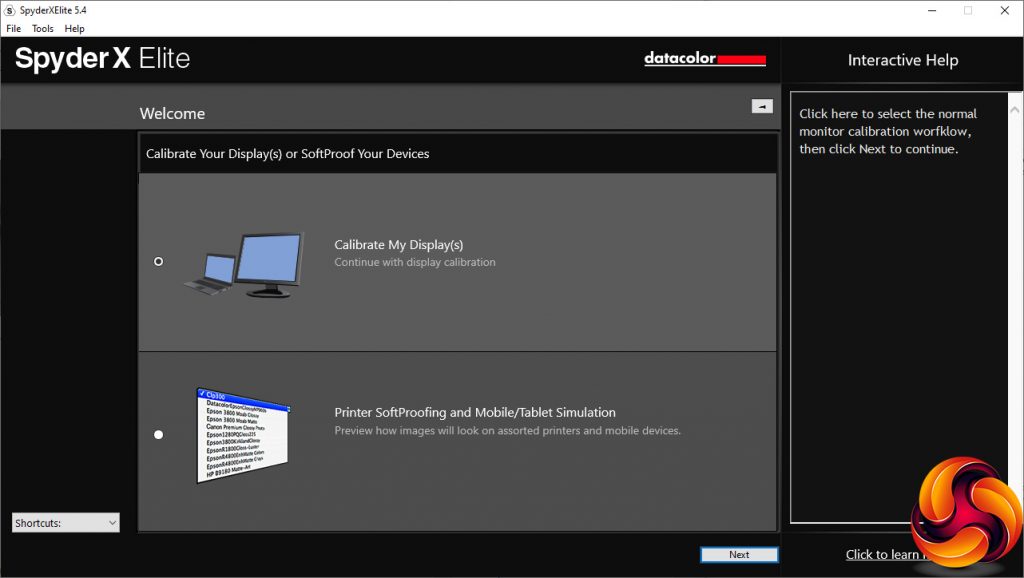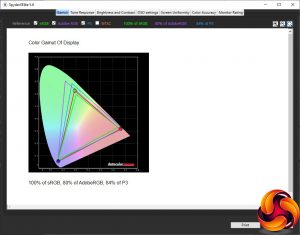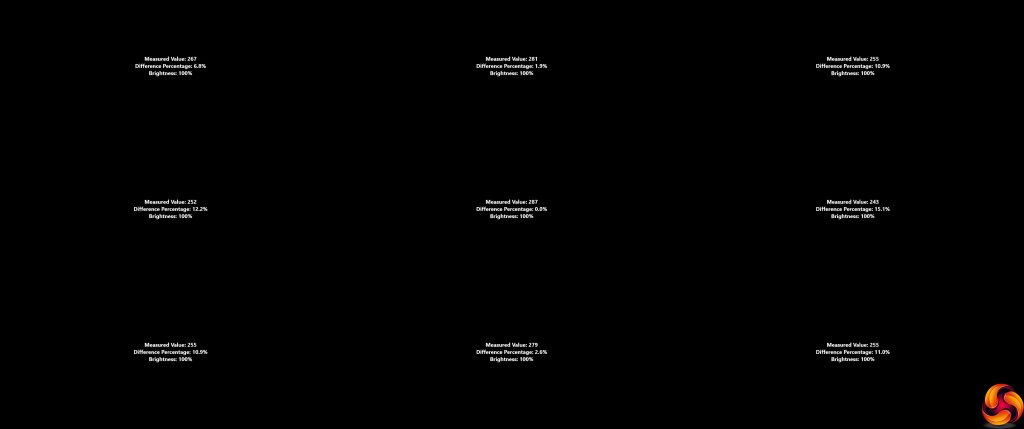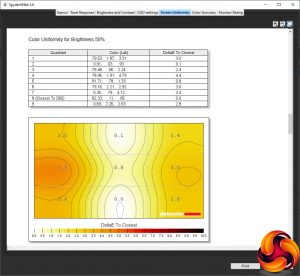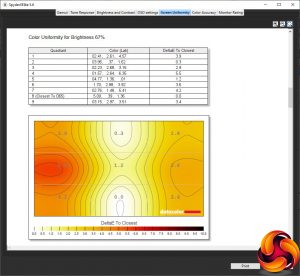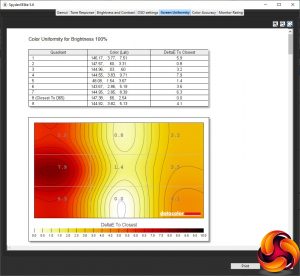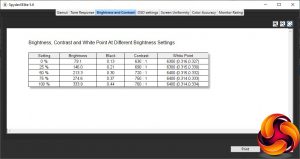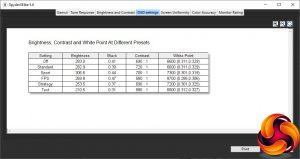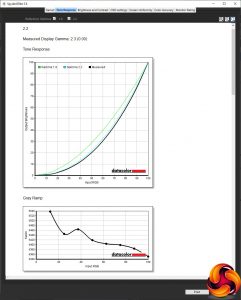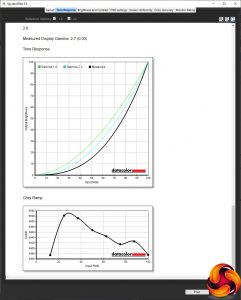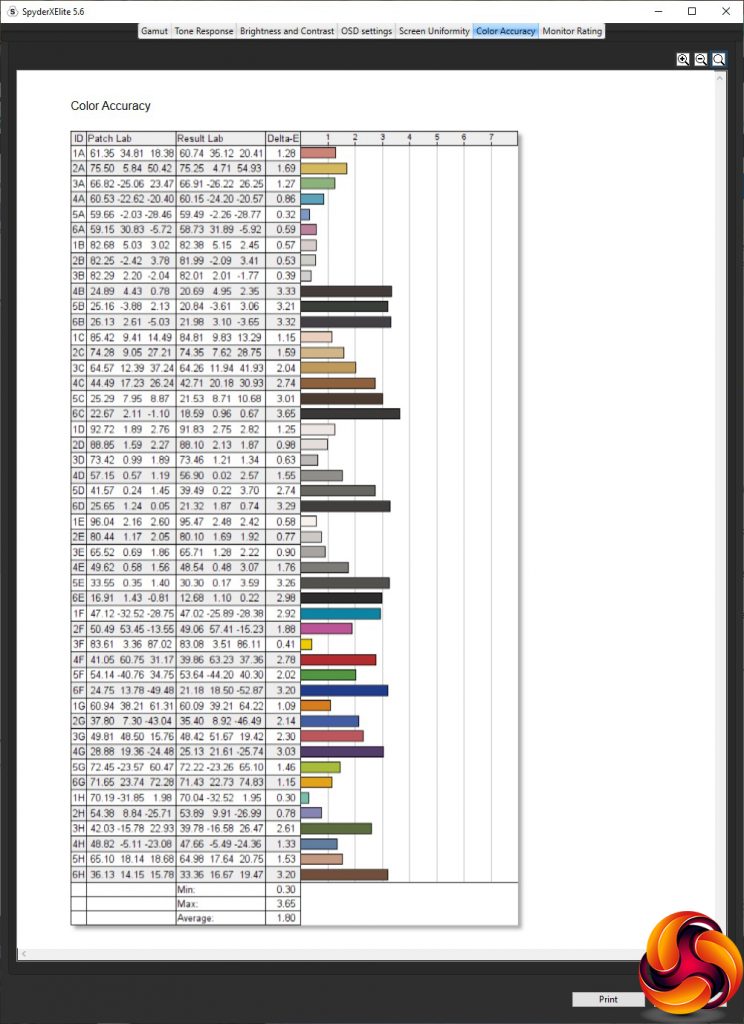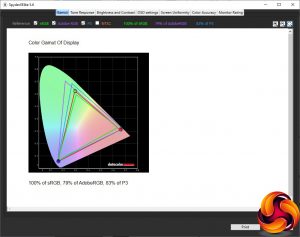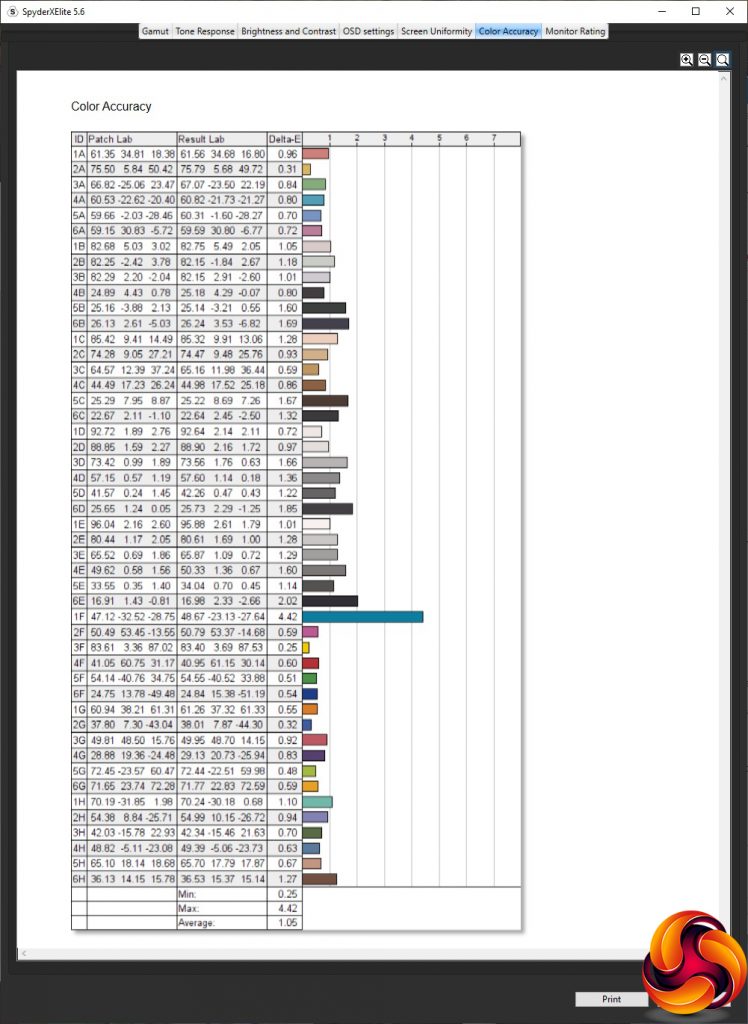Our main test involves using a DataColor SpyderX Colorimeter to assess a display’s image quality. The device sits on top of the screen while the software generates colour tones and patterns, which it compares against predetermined values to work out how accurate the screen is.
The results show –
- A monitor’s maximum brightness in candelas or cd/m2 at various levels set in the OSD.
- A monitor’s contrast ratio at various brightness levels in the OSD.
- The brightness deviation across the panel.
- The black and white points.
- The colour accuracy, expressed as a Delta E ratio, with a result under 3 being fine for normal use, and under 2 being great for colour-accurate design work.
- The exact gamma levels, with a comparison against preset settings in the OSD.
We first run this test with the display in its default, out-of-the-box state, with all settings on default after a factory reset. We then calibrate the screen using the Spyder software and run the test again.
We always test the display subjectively on the Windows desktop, using it for general tasks such as browsing and word processing, and with games as well, even if the display is not intended solely for that purpose.
We pay careful attention to any artefacts, ghosting or motion blur, and enable any gaming-specific features, such as adaptive-sync settings like G-Sync or FreeSync, using a compatible graphics card in our test PC.
We performed the quality tests on the iiyama G-Master GB3461WQSU-B1 at its native 3,440 x 1,440 resolution in the default mode, after resetting the OSD, which sets the refresh to 144Hz over a DIsplayPort connection. Our test system was equipped with an AMD Radeon Vega Frontier Edition graphics card, which supports FreeSync, so we enabled that for games testing.
The gamut is reasonable, with the 100 per cent sRGB we now expect from all monitors, plus a very good 80 per cent AdobeRGB and 84 per cent DCI-P3.
Brightness uniformity is merely so-so, with problem areas along both edges apart from the top left-hand corner.
Above 50 per cent brightness the colour uniformity also starts to diverge along the left-hand edge as well.
The GB3461WQSU-B1 gets close to its specified brightness at 100 per cent, hitting 333.9cd/m2. However, even 0 per cent is 79.1cd/m2, so the overall range is around 250cd/m2, although the range seems consistently spaced as you go up the percentages. Contrast is fairly uniform, but only hits a maximum of 760:1. This is as expected for an IPS panel, which has generally much lower contrast than VA. The white point is very consistent at 6300K or 6400K, which is close to what we'd hope. A mid-range white point is usually expected to be 6500K.
There is a little bit of variation amongst the I-Style Mode presets, but not as much as we usually expect. The Off and Standard options are essentially the same, providing 283cd/m2 brightness, a 0.4 black point, between 690:1 and 720:1 contrast and a 6600K white point. Sport mode is a little brighter at 306.6cd/m2, with a higher 0.44 black and 700:1 contrast, but cooler 7300K white point.
FPS mode is less bright at 269.8cd/m2, with a slightly higher 0.47 black and lower 580:1 contrast, but much cooler 8700K white point. Strategy mode takes the brightness down a notch further to 253.5cd/m2, but black level is lower at 0.37 and contrast higher than FPS mode at 690:1, with a relatively cool 7200K white point. Finally, Text mode us unsurprisingly the least bright at 210.5cd/m2, with the lowest 0.31 black point and reasonable 680:1 contrast, plus a midrange 6600K white point.
All the gamma modes are 0.1 higher than their numbering would suggest. But at least they're consistent.
Colour accuracy is supposed to be where IPS panels shine. The GB3461WQSU-B1's score of 1.8 average deviation out of the box is good but not stunning. So, of course, as usual, we decided to calibrate the screen with the SpyderX to see if we could improve on things.
After calibration, the gamut is actually marginally worse. Although sRGB is still 100 per cent and DCI-P3 still 83 per cent, the AdobeRGB score is down a notch to 79 per cent, although this is hardly cause for concern.
We only retested the default 2.2 gamma setting, which remains at 2.3.
However, the colour accuracy has improved to an excellent 1.05. Not the absolute best we've seen, but much more in keeping with what we would expect from an IPS panel – particularly one delivered in a monitor made by iiyama.
Overall, then, a decent performance apart from brightness and colour uniformity. With calibration, you can get excellent colour fidelity out of this screen, and otherwise its brightness and contrast levels are as expected for an IPS panel.
Of course, this is a gaming-focused display so we had to fire up our usual selection of games including CS:GO, Rainbow 6 Siege and League of Legends, but added Shadow Warrior 2 for HDR support. We enabled the FPS Gaming Mode preset for the first two games, and Strategy for LoL. We also enabled FreeSync since it isn't turned on by default.
CS:GO is the best test because our AMD Radeon Vega Frontier Edition graphics card can achieve frame rates close to the refresh rate at the native 3,440 x 1,440 resolution. Note that we run this test offline, and some people have seen problems with CS:GO at this resolution online. Shadow Warrior HDR looked good, but LoL and RTS games feel like the best fit for an ultrawide aspect, or car racing. We also tried Civilization VI and found the extra screen real estate extremely enjoyable.
 KitGuru KitGuru.net – Tech News | Hardware News | Hardware Reviews | IOS | Mobile | Gaming | Graphics Cards
KitGuru KitGuru.net – Tech News | Hardware News | Hardware Reviews | IOS | Mobile | Gaming | Graphics Cards

